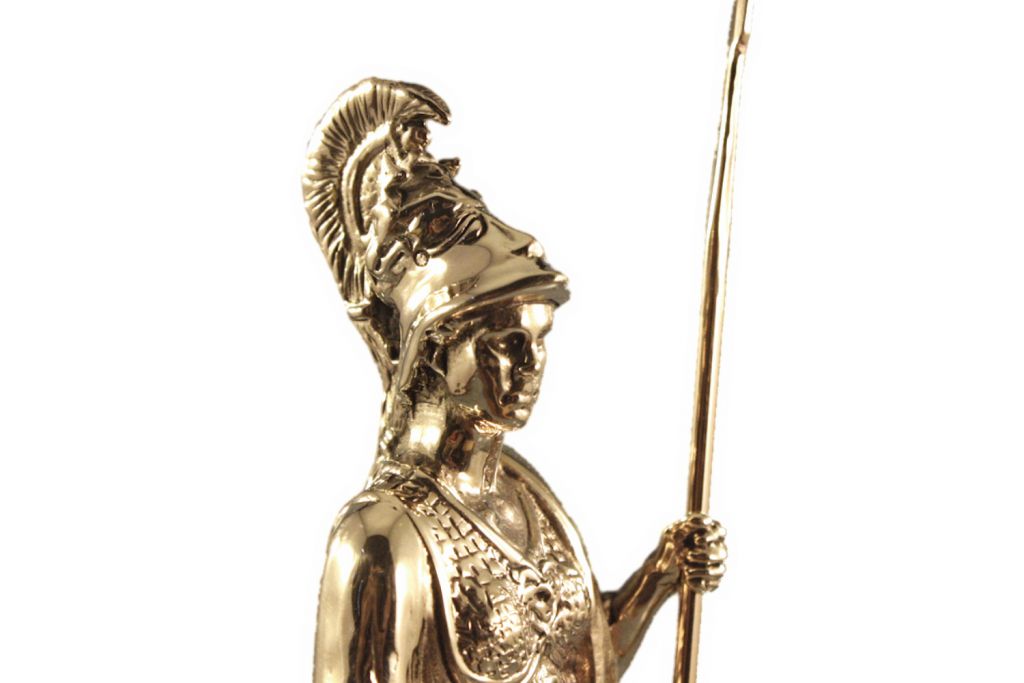Minerva (Athena) Statue, Bronze
Bronze figure of Minerva / Athena. Very high quality small statue made of genuine and solid bronze.
Bronze figure of Minerva / Athena
Small bronze figures like these were used for rituals, mostly in private house altars (Lararien). The quality of the figures was very different and could vary from simple, somewhat awkward acting figures to a high-quality and natural appearance. For the best figures, precious silver was sometimes used as a material for the production, simple pieces consisted of clay.
Our Minerva is a free and idealized work, which is based on different representations, marble statues and bronze figures. The starting point was a statue from the Museum Bologna, which was reduced in size and completely reworked to a roman Lararium´s figure. In particular, helmet, body and arm postures were redesigned with the aim to produce "the best" bronze figure of Minerva as I would have made 2000 years ago. Not only the artistic quality is outstanding compared to the original pieces, also the production and the material are correspondingly complex and authentic. The statue of the Minerva / Athena is actually made of genuine and solid bronze, which was processed in the lost wax casting. It is not a patinated cast of tin or industrial zinc, or even a synthetic resin with metal powder, but pure and elaborate, traditional handcraft in an authentic alloy. Each Minerva / Athena is individually cast from a wax model and made by hand individually, so there may be small differences from figure to figure. The statue of Minerva / Athena is extremely rich in details. In addition to the elaborately pleated garment with breastplate, the goddess wears a helmet with a crest and ornaments in the shape of the winged horse Pegasus. The small portrait of a Medusa decorates the breast armor. In her right hand Minerva holds a sacrificial bowl (Patera), asking for offerings.
Since each figure is made individually, the delivery time is usually 2 to 3 weeks. Height of Minerva statue with pedestal (without spear) about 15.3 cm.
Our Minerva is a free and idealized work, which is based on different representations, marble statues and bronze figures. The starting point was a statue from the Museum Bologna, which was reduced in size and completely reworked to a roman Lararium´s figure. In particular, helmet, body and arm postures were redesigned with the aim to produce "the best" bronze figure of Minerva as I would have made 2000 years ago. Not only the artistic quality is outstanding compared to the original pieces, also the production and the material are correspondingly complex and authentic. The statue of the Minerva / Athena is actually made of genuine and solid bronze, which was processed in the lost wax casting. It is not a patinated cast of tin or industrial zinc, or even a synthetic resin with metal powder, but pure and elaborate, traditional handcraft in an authentic alloy. Each Minerva / Athena is individually cast from a wax model and made by hand individually, so there may be small differences from figure to figure. The statue of Minerva / Athena is extremely rich in details. In addition to the elaborately pleated garment with breastplate, the goddess wears a helmet with a crest and ornaments in the shape of the winged horse Pegasus. The small portrait of a Medusa decorates the breast armor. In her right hand Minerva holds a sacrificial bowl (Patera), asking for offerings.
Since each figure is made individually, the delivery time is usually 2 to 3 weeks. Height of Minerva statue with pedestal (without spear) about 15.3 cm.
Bronze figure Minerva / Athena
Originally an Italian goddess, Minerva was already worshiped by the Sabines, Etruscans and early Romans. She was especially the protector of craftsmen and trade. Due to the influence of Greek colonies on Italian soil, attributes of the Greek Athena were increasingly transferred to Minerva. She became the goddess of wisdom and patron saint of teachers, artists and poets. As a defensive goddess with shield and spear, she was also the goddess of tactical warfare, in contrast to the impulsive war god Mars. Under her care were doctors as well as weavers or shipbuilders. Celebrations in her honor were especially committed by artisan associations.
The great importance of Minerva can be seen from the fact that she was a city deity of the Capitoline Triad, together with Jupiter and Juno. A sanctuary of these three supreme deities was called Capitolium, with the most important place of worship on the afterwards named Capitol Hill in Rome. In addition, another temple of Minerva was on the Aventine.
According to legend, the Greek Athena sprang from the head of the father of the god Zeus. Her armor, sometimes the shield, adorns the head of the dreadful Medusa, which had been slain by Perseues with her help. She is called the "owl-eyed" in poetry, and the bird was closely associated with her. Since then, owls have been considered the birds of wisdom and they were a special symbol of the Greek capital of Athens, where the main sanctuary of Athena was on the Acropolis.
According to legend, the Greek Athena sprang from the head of the father of the god Zeus. Her armor, sometimes the shield, adorns the head of the dreadful Medusa, which had been slain by Perseues with her help. She is called the "owl-eyed" in poetry, and the bird was closely associated with her. Since then, owls have been considered the birds of wisdom and they were a special symbol of the Greek capital of Athens, where the main sanctuary of Athena was on the Acropolis.
Minerva Statue - The religion of the ancient Romans
At the time of the early republic, the Romans had an independent, rural religion in an agricultural society, which is difficult to find archaeologically. The main focus was on powers of fertility and protective deities for humans and animals.
With the expansion of the Roman sphere of power and the contact with Etruscans and Greek colonies, the beliefs changed. The ancient gods were increasingly adapted to the Greek cult and equaled. On the one hand, there were the twelve known "Dei Consentes," which, according to the beliefs of the Greeks, represent the gods of Olympus. These included Jupiter as the supreme god, as well as Juno, Neptune, Minerva, Mars, Venus, Apollo, Diana, Vulcanus, Vesta, Mercury and Ceres. In addition, there were numerous other gods such as Aeolus, the god of the wind, Luna, the goddess of the moon or Fortuna as a goddess of fortune.
A peculiarity of the Greek and Roman religions are personifications of qualities and virtues, such as Justitia, the goddess of justice, Pax as a goddess of peace, Virtus (valor), Concordia (concord) or Victoria (victory). Deities were also considered to be personifications of certain cities, countries and peoples, such as Roma, the patron goddess of the city of Rome. The enthusiasm of the Romans for the Greek culture meant that the appearance of the gods and their representation in the arts were adopted almost identically. Many outstanding Greek sculptures and statues are no longer preserved in the original, but still exist today as copies from later Roman times.
In addition to the public cult of the state gods, there was the private cult practiced on house altars within families and households. Here, especially private guardian gods of the house and its inhabitants were worshiped, the Laren and Penaten, as well as the genius as guardian spirit of the host, the "Father Familias" as the head of the extended family.
Other gods, which had a special bond in the form of oaths, promises or personal fortunes, were worshiped in private worship. Above all, Mercury as God's trade and money is often to be found as a small figure of gods in the house altars, the so-called Lararia.
With the expansion of the Roman sphere of power and the contact with Etruscans and Greek colonies, the beliefs changed. The ancient gods were increasingly adapted to the Greek cult and equaled. On the one hand, there were the twelve known "Dei Consentes," which, according to the beliefs of the Greeks, represent the gods of Olympus. These included Jupiter as the supreme god, as well as Juno, Neptune, Minerva, Mars, Venus, Apollo, Diana, Vulcanus, Vesta, Mercury and Ceres. In addition, there were numerous other gods such as Aeolus, the god of the wind, Luna, the goddess of the moon or Fortuna as a goddess of fortune.
A peculiarity of the Greek and Roman religions are personifications of qualities and virtues, such as Justitia, the goddess of justice, Pax as a goddess of peace, Virtus (valor), Concordia (concord) or Victoria (victory). Deities were also considered to be personifications of certain cities, countries and peoples, such as Roma, the patron goddess of the city of Rome. The enthusiasm of the Romans for the Greek culture meant that the appearance of the gods and their representation in the arts were adopted almost identically. Many outstanding Greek sculptures and statues are no longer preserved in the original, but still exist today as copies from later Roman times.
In addition to the public cult of the state gods, there was the private cult practiced on house altars within families and households. Here, especially private guardian gods of the house and its inhabitants were worshiped, the Laren and Penaten, as well as the genius as guardian spirit of the host, the "Father Familias" as the head of the extended family.
Other gods, which had a special bond in the form of oaths, promises or personal fortunes, were worshiped in private worship. Above all, Mercury as God's trade and money is often to be found as a small figure of gods in the house altars, the so-called Lararia.
| Delivery time | 3-4 weeks |
|---|---|
| weight | 0.370000 |
| size | 15,3 cm |
| Era | Romans |
| Material | Bronze |
| Kind of replica | Gods and cult |
Write Your Own Review

